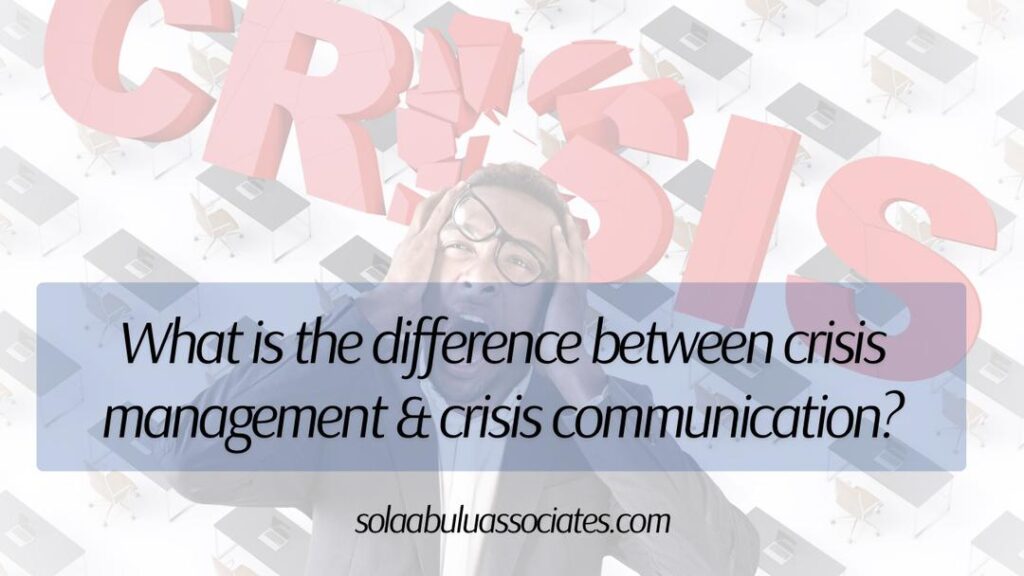What is the difference between crisis management and crisis communication?

Crisis management is the entire process of how a crisis is managed or handled. It involves the aggrieved audience or stakeholder group, the decisions made to resolve the crisis, the communications response and all the processes/policies that are put in place to avoid a repetition of the negative sentiments and most importantly, the attempt to restore a positive brand reputation.
Crisis communication is at the heart of crisis management because it is an intentional, purposeful and strategic step that is carried out to address negative sentiments that are raised. Crisis management requires that actions are taken promptly and proactively with care. Crisis communications is part of any crisis management process; however, other processes ensure effective crisis management.
Crisis communication deals with the response, engagement, stakeholder mapping and stakeholder management that should happen in a crisis scenario while crisis management is more focused on actions alone. A crisis management structure that integrates strategic communications always stress-tests and synergizes the response so it is operationally correct. When there is no such crisis management structure, it becomes easy for the communications to fail meaning that it would lack the ability to de-escalate the negative sentiment and stop the spread. Instead, more negative news will arise from the communications response that has the possibility to damage the reputation.
It is poor crisis communication to create a message that only denies the sentiments. Crisis communication is strategic because it has to be purposeful. In the instance where the sentiments may not be true, the communications response will state that the business or entity is cooperating with necessary bodies to conduct investigations. Another example is a crisis emanating from construction or energy industry site work. It can be a life-threatening or safety crisis. An effective crisis communication will state that the organization involved has actively deployed emergency response to the site. This is why strategic communications is a critical enabler for crisis management.
Therefore, crisis management and crisis communication are different but interconnected. While crisis communication involves the strategic communications effort to de-escalate the negative news in the media, crisis management is the entire on-ground processes taking place to achieve the same purpose of de-escalating the news, restoring normalcy to operations and maintaining a positive brand reputation and perception in the media. Learn the best practices for managing public perception in this article.
We can describe a scenario as a crisis when it affects the reputation of an organization, business or brand which can also be personal. In cases of a crisis, oftentimes, the entities involved are at risk of losing their license to operate and stakeholder’s trust. If you run a business, organization or personal brand and a negative sentiment around your entity grows to the point where the media begins to publish it, regulatory bodies are making inputs or you begin to have tons of calls from your allies, you are in a crisis. This best defines when a crisis has occurred. A crisis can also occur from natural hazards like floods, etc. This paper examines the models used in some African countries (Nigeria, Uganda and Mauritania) for crisis management with emphasis on natural and human-induced crises.
Characteristics of a good crisis management process
- A strong and experienced leader: This is best achieved with either the founder, business leaders or executive officers. It has to be the most influential decision-maker leading the crisis management effort.
- A crisis communications lead: This should be a strategic communications professional who can integrate strategic communications into crisis management. The crisis communications lead supports the business leader and is saddled with the responsibility of handling crisis response.
- A support role that co-ordinates activities. It is also very preferable to have an integral member of the business or system handle this responsibility.
- The extended crisis management team. This team can involve the customer service staff, health and safety officers, operations, procurement, finance or legal. The make-up of this team is dependent on the kind of crisis that the brand is faced with.
As much as crisis management and crisis communications are interconnected, understanding the unique importance of crisis communication in any crisis management process helps businesses, organizations, brand and any given entity to put in place a working and updated structure for crisis communication.
If you want to learn the best-practices to adopt in a crisis management, you should be in the second cohort of our CPD Standards Office-Accredited Issues, Crisis and Reputation Management Course on the 31st of October. Sign up here.
………………………………………….
Sola Abulu & Associates is a strategy and communications consulting and training firm committed to enabling businesses, brands and organizations to achieve their objectives through strategic communications, organizational effectiveness and reputation risk management
Chat with us for more information on our courses.
